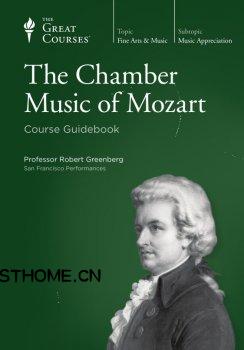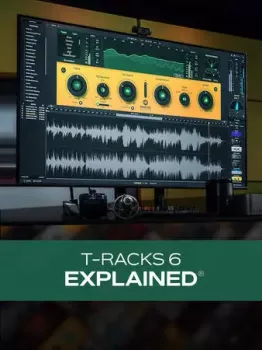Publisher: The Great Curses Plus | English | MP4+PDF |1280x720 | 29fps | 12h | stereo 189kbps | 11.70 GB
英文简介:
Examine the music and the man behind it with a music historian as you study and enjoy a variety of chamber works drawn primarily from Mozart's "golden years.” Focus on works that represent the three types of chamber music.
Lectures info:
01 Mozart's chamber music ranks among his finest work, making it some of the greatest music ever written. We will listen to a few selections as a preview of the extraordinary pieces of chamber music we will study.
02 Mozart's String Quartet in Bb Major, K. 458, subtitled "The Hunt," exemplifies the Viennese Classical style at its zenith. In this work, we will see how Mozart connected and metamorphosed musical ideas, and appreciate his advanced compositional technique.
03 Our in-depth analysis of Mozart's "Hunt" Quartet will reveal the workings of sonata form, the most important musical structural innovation of the Classical era. This work also provides an opportunity to observe the compositional details that set Mozart's music apart.
04 In this lecture and the next, we will look at Mozart's life before he settled in Vienna, and examine his Flute Quartet in D Major, K. 285, of 1777. It features a flute solo that the great musicologist Alfred Einstein described as "perhaps the most beautiful accompanied solo ever written for the flute."
05 Mozart plunged into the musical life of Vienna as a composer and performer. His first big splash came with the "Auernhammer" Sonatas for Violin and Piano, published in December, 1781. The Sonata K. 380 exemplifies these works, which feature the violin and piano as equal partners in an ongoing musical conversation.
06 Mozart was 25 when he met 49-year-old Joseph Haydn. Although very different personalities, they quickly became good friends. Haydn's biographer, Karl Geiringer, claimed that Mozart learned to compose string quartets solely from Haydn. In this lecture, we study the "Haydn" String Quartet in G Major, K. 387.
07 Many of Mozart's chamber works were written to be performed by his friends. The Oboe Quartet of 1781 was composed for the great oboist Friedrich Ramm. Mozart's Horn Quintet of 1782 was written for Joseph Leutgeb, a master of the hand-horn. This lecture also examines three of Mozart's demanding Twelve Duos for Horn, written, according to Mozart, "while bowling."
08 Mozart's collaborations with composer Michael Haydn—who is less well known today, but was highly respected in his time—caused huge problems of attribution for posterity. Mozart's two Duets for Violin and Viola, K. 423 and K. 424, are cases in point. He wrote them "as" Michael Haydn, who was too ill to fulfill a commission for them.
09 Mozart's major works were never perceived as "easy listening" during his life. His dark and dissonant String Quartet in D Minor, K. 421, completed in 1783, represents the kind of music that challenged Mozart's audiences. His third "Haydn" Quartet in E flat Major, K. 428, is a striking contrast. It contains the most explicitly Haydnesque music of all the "Haydn" quartets.
10 Mozart's Quintet in E flat Major for Piano, Oboe, Clarinet, Horn, and Bassoon, K. 452, 1784, was, he believed, the best work he had composed to that point. Two years later, inspired by the great clarinetist Anton Stadler, he composed the Trio in E flat Major for Clarinet, Viola, and Piano, K. 498. Mozart's compositions for clarinet remain the core repertoire for that instrument.
11 Mozart virtually invented the piano trio as we understand it today, and composed six of them. This lecture examines the Divertimento in Bb Major, K. 254; the Piano Trio in B flat Major, K. 502, 1786; and the Piano Trio in E Major, K. 542, 1788. At this time, Mozart's finances and health were in disarray, yet still he composed beautiful, technically perfect music at breakneck speed.
12 By the mid to late 1780s, Mozart no longer tried to appeal to a mass audience. This refusal to "dumb down" his music is most apparent in his two piano quartets, written between 1785 and 1786. They are large-scale works in terms of their length and grandeur of conception.
13 In this lecture, we examine the fifth of Mozart's "Haydn" Quartets, the String Quartet in A Major, K. 464. Musicologist Alan Kriegsman described this work as "the most stunning example of musical craftsmanship among the six 'Haydn' Quartets."
14 By the 1780s, Mozart's artistic vision had gone far beyond that of his contemporaries. His string quintets did not sell well, although posterity has benefited from his desire to challenge this difficult medium. In this lecture, we examine four string quintets—all are transcendental masterworks.
15 Mozart completed his String Quartet in C Major, K. 465, the so-called "Dissonant" Quartet, in 1785. This sixth and last of Mozart "Haydn" Quartets exhibits an expressive depth and a dark side that exceeded what was then considered appropriate and tasteful. By the late 1780s, Mozart's "difficult" music so alienated his Viennese patrons that his financial situation turned disastrous.
16 Mozart wrote his Clarinet Quintet, K. 581, of 1790, and his Clarinet Concerto, K. 622, of 1791, for the basset clarinet (or basset horn), invented by Anton Stadler, one of the finest clarinetists of his day. Mozart's last chamber composition was his Adagio in C Minor and Rondo in C Major for Flute, Oboe, Viola, 'Cello, and Glass Harmonica, K. 617.
官网: https://www.thegreatcoursesplus.com/show/chamber_music_of_mozart







评论0